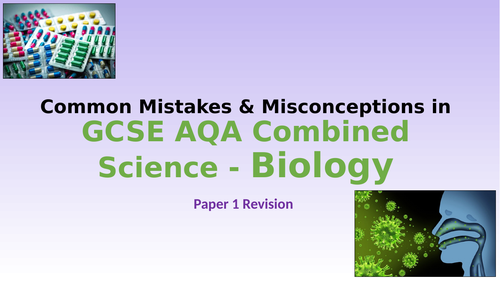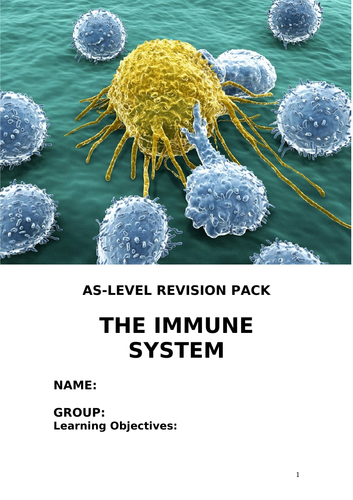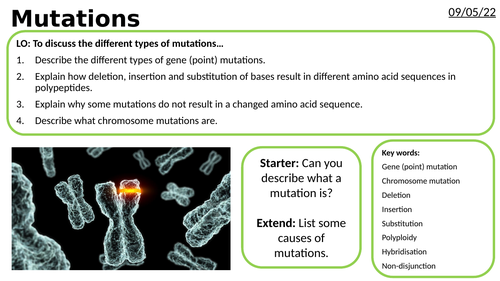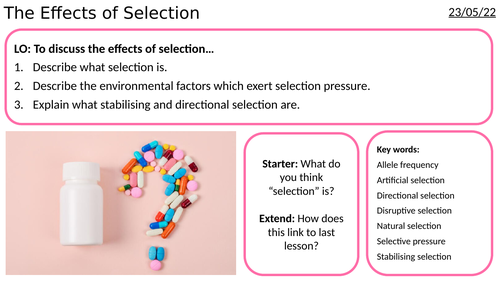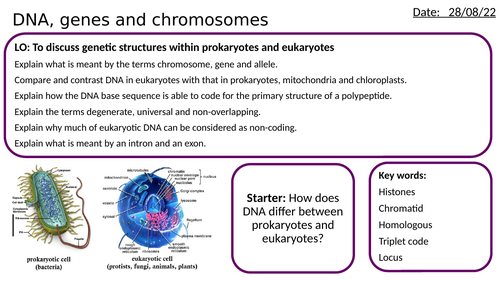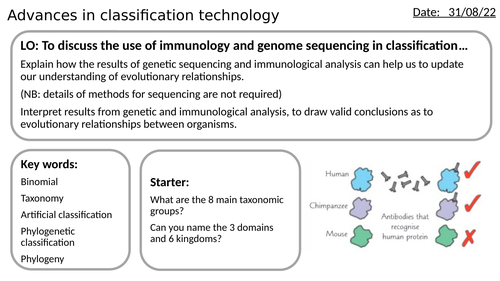63Uploads
16k+Views
13k+Downloads
All resources

Year 8/9 KS3/KS4 Chemistry Combustion Burning Fuels Full Lesson
Full KS3 (Year 8) lesson on combustion, including differentiated starter and plenary.
Covers the following LOs…
LO) To describe the differences between complete and incomplete combustion.
State the products of complete and incomplete combustion.
Describe the problems associated with the products of incomplete combustion.
Construct word and symbol equations for the complete combustion of simple hydrocarbons.

AS/A2-Level AQA Biology Quantitative Investigations of Diversity Full Lesson
A full 60 minute lesson on Quantitative Investigations of Diversity, covering the following LOs…
Explain how random samples can be obtained.
Explain what standard deviation is and how it is calculated.
Represent raw and processed data clearly using tables and graphs.
Interpret data in terms of means and the overlap of standard deviation bars.
Apply knowledge of, to draw and explain conclusions.
Evaluate the quality of results and reliability of conclusions.
Lesson includes starter task, recall questions (and answers), and also practice exam questions (and mark scheme).

GCSE AQA Trilogy Combined Science Biology Paper 1 Revision Lesson
**GCSE AQA Trilogy Combined Science Biology Paper 1 Revision Lesson
**
1 hour revision lesson on Common Mistakes and Misconceptions in GCSE AQA Combined Science Biology, with a focus on Paper 1 topics (B1, B2, B3 and B4). Includes…
Common mistakes and misconceptions in topic B3 (Infection and Response), with exam tips, practice questions and answers.
Common mistakes and misconceptions in topic B4 (Bioenergetics), with exam tips, practice questions and answers.
Retrieval quiz (with answers) on topics B1 (Cell Biology) and B2 (Organisation).
6 mark exam question practice (with mark schemes) for foundation tier and higher tier students.

AS/A2-Level AQA Biology Photosynthetic Pigments and Chromatography Full Lesson
A full lesson on Photosynthetic Pigments and Chromatography, covering the following LOs…
State the precise location of the pigments involved in photosynthesis within the leaf.
Outline the role of the leaf pigments in photosynthesis.
Explain why many plants have a variety of photosynthetic pigments.
Describe how to investigate photosynthetic pigments using chromatography.
Lesson includes starter task, two sets of practice exam questions (and mark schemes), practical questions, and student sheet for Required Practical 7 - Use of chromatography to investigate the pigments isolated from leaves of different plants.

AS/A2 Level Year 12/13 Immune System Immunity Revision Booklet Pack
Revision pack for students to fill out (including exam tips and practice questions), covering the following topics on the immune system…
LO1) Describe the physical and chemical (non-specific) defences against pathogens in animals, including the skin, blood clotting, wound repair, inflammation, expulsive reflexes and mucous membranes.
LO2) Describe the structure and mode of action of phagocytes in the non-specific (innate) immune response, including neutrophils and antigen-presenting cells and the roles of cytokines, opsonins, phagosomes and lysosomes.
LO3) Describe the structure, different roles and modes of action of T lymphocytes in the specific (adaptive) immune response, including clonal selection and clonal expansion, T helper cells, T killer cells, T regulatory cells and memory cells.
LO4) Describe the structure, different roles and modes of action of B lymphocytes in the specific (adaptive) immune response, including plasma cells and memory cells.
LO5) Explain the significance of cell signaling, with reference to interleukins.
LO6) Examine and draw cells observed in blood smears.
LO7) Describe the structure and functions of antibodies.
LO8) Describe the actions of agglutinins and anti-toxins.
LO9) Describe the difference between primary and secondary immune responses, including the roles of T memory and B memory cells.
LO10) Describe the differences between active and passive immunity, and between natural and artificial immunity, and state examples of each.
LO11) Describe what autoimmunity is, and give examples.
LO12) Explain the main principles of vaccination and the role of vaccination programmes in the prevention of epidemics.

AS/A2 Level Year 12/13 Immune System Immunity Full Lesson Presentation
Presentation covering the following information…
LO1) Describe the physical and chemical (non-specific) defences against pathogens in animals, including the skin, blood clotting, wound repair, inflammation, expulsive reflexes and mucous membranes.
LO2) Describe the structure and mode of action of phagocytes in the non-specific (innate) immune response, including neutrophils and antigen-presenting cells and the roles of cytokines, opsonins, phagosomes and lysosomes.
LO3) Describe the structure, different roles and modes of action of T lymphocytes in the specific (adaptive) immune response, including clonal selection and clonal expansion, T helper cells, T killer cells, T regulatory cells and memory cells.
LO4) Describe the structure, different roles and modes of action of B lymphocytes in the specific (adaptive) immune response, including plasma cells and memory cells.
LO5) Explain the significance of cell signaling, with reference to interleukins.
To accompany my “AS Immune System” Student Revision Booklet Pack (see other resources).

AS/A2-Level AQA Biology Gene and Chromosome Mutations Full Lesson
A full 60 minute lesson on Mutations, covering the following LOs…
Describe the different types of gene (point) mutations.
Explain how deletion, insertion and substitution of bases result in different amino acid sequences in polypeptides.
Explain why some mutations do not result in a changed amino acid sequence.
Describe what chromosome mutations are.
Lesson includes starter task, summary questions (and answers), plenary, and also a homelearning task with practice exam questions (and mark scheme).

AS/A2-Level AQA Biology Meiosis and Genetic Variation Full Lesson
A full 60 minute lesson on Meiosis, covering the following LOs…
Describe why meiosis is necessary.
Describe the process of meiosis.
Explain how meiosis creates genetic variation.
Lesson includes starter task, comprehension task, meiosis diagram sheet, summary questions (and answers), plenary, and also a homelearning task with practice exam questions (and mark scheme).

AS/A2-Level AQA Biology Genetic Diversity and Adaptation Full Lesson
A full 60 minute lesson on Genetic Diversity and Adaptation, covering the following LOs…
Explain why organisms are different from one another.
Describe what factors influence genetic diversity.
Explain how reproductive success affects allele frequency within a gene pool.
Explain how genetic diversity enables natural selection.
Lesson includes starter task, summary questions (and answers), plenary, and also a homelearning task with practice exam questions (and mark scheme).

AS/A2-Level AQA Biology The Effects of Selection Full Lesson
A full 60 minute lesson on The Effects of Selection, covering the following LOs…
Describe what selection is.
Describe the environmental factors which exert selection pressure.
Explain what stabilising and directional selection are.
Lesson includes starter task, summary questions (and answers), plenary, and also a homelearning task with practice exam questions (and mark scheme).

AS/A2-Level AQA Biology DNA, Genes and Chromosomes Full Lesson
A full 60 minute lesson on DNA, Genes and Chromosomes, covering the following LOs…
Explain what is meant by the terms chromosome, gene and allele.
Compare and contrast DNA in eukaryotes with that in prokaryotes, mitochondria and chloroplasts.
Explain how the DNA base sequence is able to code for the primary structure of a polypeptide.
Explain the terms degenerate, universal and non-overlapping.
Explain why much of eukaryotic DNA can be considered as non-coding.
Explain what is meant by an intron and an exon.
Lesson includes starter task, summary questions (and answers), and practice exam questions (and mark scheme).

AS/A2-Level AQA Biology Protein Synthesis - Transcription Full Lesson
A full lesson on Transcription (Protein Synthesis), covering the following LOs…
Explain what the terms genome and proteome mean.
Describe the structure of mRNA and how it is related to its function (link to biological molecules topic).
Explain the process of transcription in prokaryotes.
Explain the process of transcription and splicing in eukaryotes, linking this to knowledge of introns.
Interpret data from experimental work investigating the role of nucleic acids.
Lesson includes starter task and summary questions (and answers).

AS/A2-Level AQA Biology Protein Synthesis - Translation Full Lesson
A full lesson on Translation (Protein Synthesis), covering the following LOs…
Explain the process of translation.
Explain the specific roles of ribosomes, ATP and tRNA in translation.
Describe the structure of tRNA and how it is related to its function.
Relate the base sequence of nucleic acids to the amino acid sequence of polypeptides, when provided with suitable data about the genetic code.
Lesson includes starter task, summary questions (and answers), and practice exam questions (and mark scheme).
Bundle

AS/A2-Level AQA Biology - Topic 4: Genetic Information, Variation & Relationships between Organisms *14 LESSON BUNDLE*
AS/A2-Level AQA Biology - Topic 4: Genetic Information, Variation & Relationships between Organisms 14 LESSON BUNDLE
INCLUDES THE FOLLOWING LESSONS…
DNA, genes and chromosomes
Protein synthesis - transcription
Protein synthesis - translation
Gene and chromosome mutations
Meiosis and genetic variation
Genetic diversity and adaptation
The effects of selection
RP6 Investigating selection aseptic technique antibiotics bacterial growth
Classification (phylogeny, taxonomy)
Advances in classification technology
Species (courtship displays/behaviour)
Biodiversity (within a community)
Investigating diversity
Quantitative investigations of diversity
Individual lessons worth £39! Save 33% by buying the bundle.

AS/A2-Level AQA Biology Biodiversity (within a community) Full Lesson
A full 60 minute lesson on Biodiversity (within a community), covering the following LOs…
Explain what is meant by the terms biodiversity, species richness and index of diversity.
Calculate the index of diversity when supplied with relevant information.
Interpret information and draw conclusions from the index of diversity for different habitats.
Explain how farming techniques impact on biodiversity and the reason why these techniques are used.
Evaluate conservation techniques and why these must be balanced with farming.
Lesson includes starter task, recall questions (and answers), and also practice exam questions (and mark scheme).

AS/A2-Level AQA Biology Species (Courtship Displays/Behaviour) Full Lesson
A full 60 minute lesson on Species (Courtship Displays/Behaviour), covering the following LOs…
Explain what a species is.
Appreciate the difficulties in defining the term species.
Explain the role of courtship and why it is necessary.
Interpret information and data relating to courtship displays.
Lesson includes starter task, class discussion, and practice exam questions (and mark scheme).

AS/A2-Level AQA Biology Testing for Carbohydrates Iodine Test Benedict's Test Full Lesson
A full lesson on Testing for Carbohydrates, covering the following LOs…
Describe the test for reducing and non-reducing sugars.
Explain when the Benedict’s test can be described as both qualitative, semi-quantitative and quantitative.
Analyse results obtained from the Benedict’s test.
Lesson includes starter task, summary questions (with answers), and practice questions (with mark scheme).

AS/A2-Level AQA Biology Advances in Classification Technologies Full Lesson
A full lesson on Advances in Classification Technologies, covering the following LOs…
Explain how the results of genetic sequencing and immunological analysis can help us to update our understanding of evolutionary relationships.
Interpret results from genetic and immunological analysis, to draw valid conclusions as to evolutionary relationships between organisms.
Lesson includes starter task, and practice exam questions (and mark scheme).
Bundle

AS/A2 Level (OCR) Year 12/13 Immune System Immunity Revision/Self-Learning Pack (Home Learning Resource)
AS/A2 Level Year 12/13 Immune System Immunity Revision/Self-Learning Pack (Home learning resource)
Bundle contains…
AS/A2 Level Year 12/13 Immune System Immunity PowerPoint Presentation
AS/A2 Level Year 12/13 Immune System Immunity Revision Booklet
Students can use the PowerPoint Presentation to work their way through the Revision booklet activities and practice questions (up to the Section on “Cell signaling and the immune response”).
After this, you should encourage your students to use a variety of resources to research the answers to the last few sections of the booklet themselves.
Perfect for self/home-learning and/or revision of a particularly tricky topic.
Made for OCR, but can be adapted to suit different exam boards.
PRICE HAS BEEN REDUCED SINCE REVIEW :)

AS/A2-Level AQA Biology RP6 Investigating Selection Aseptic Technique Antibiotics Bacterial Growth
A PowerPoint on “Investigating Selection” to accompany the Required Practical on Antibiotics & Bacterial Growth (Aseptic Technique), covering the following LO…
Be able to use aseptic techniques to investigate the effect of antimicrobial substances on microbial growth (RP6).
Lesson includes starter task, plenary, home learning task (practice exam questions and mark scheme), and also a student practical sheet (with equipment list, risk assessment, method, extension questions, and teacher marking criteria).
Please check out my other AS/A-Level AQA Biology resources for this topic :)



